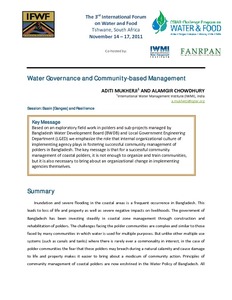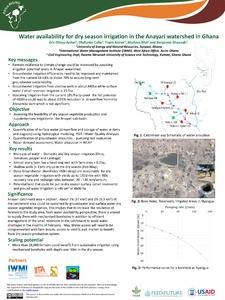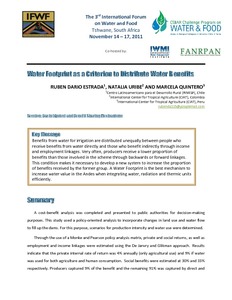Water implications of large-scale land acquisitions in Ghana.
This paper examines the water dimensions of recent large-scale land acquisitions for biofuel production in the Ashanti, Brong-Ahafo and Northern regions of Ghana. Using secondary sources of data complemented by individual and group interviews, the paper reveals an almost universal lack of consideration of the implications of large-scale land deals for crop water requirements, the ecological functions of freshwater ecosystems and water rights of local smallholder farmers and other users.
Wastewater reuse in agriculture in Vietnam: water management, environment and human health aspects. Proceedings of a workshop held in Hanoi, Vietnam, 14 March 2001
This working paper contains the proceedings of the workshop that was organized on 14 March 2001 in Hanoi, gathering experts from the various disciplines such as health, environment,water resources management, irrigation, agriculture, soil sciences, water quality, etc. to discuss the findings of 16 papers on different aspects of wastewater reuse. The proceedings of this workshop are presented here in summary form, which we hope will provide a bird's-eye view of the current knowledge in Vietnam on this subject to a wide spectrum of interested persons.
Water availability for dry season irrigation in the Anayari watershed in Ghana
Visualizing clogging up of soil pores in tropical degraded soils and their impact on green water productivity
Restrictive soil layers commonly known as hardpans restrict water and airflow in the soil profile and impede plant root growth below the plough depth. Preventing hardpans to form or ameliorate existing hardpans will allow plants root more deeply, increase water infiltration and reduce runoff, all resulting in greater amounts of water available for the crop (i.e. green water).
Water and food security: integrated scientific and governance based solutions
Water intake and nutrient balances of Holstein X Boran cows fed a low-quality tropical diet
Study was conducted to determine turnover of water, nitrogen and energy in lactating Holstein x Boran cows. Nine cows (Bos indicus × B. taurus) between their 42nd and 420th the days of lactation were selected for this study. The crossbred cows had ad libitum access to water and a dried maize stover/lablab mixture (3:1), and received 3.2 kg of concentrate (wheat bran, molasses, bone meal) and 3 kg of fresh Napier grass per day.





